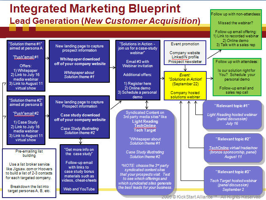
By Stephan Dietrich, President, Neolane, Inc.
While BtoB marketers might scoff at the simplicity and brevity generally associated with BtoC sales cycles, there is a lot that can be learned from the land of instant discounts and promotions. BtoC marketers have traditionally been focused on lead acquisition, and they excel at it. Considering contrasting lead generation approaches including long campaign cycles and multiple touch points, many BtoB marketers face a skills gap compared to their BtoC counterparts as they try to leverage prospect and customer data in a similar way to accelerate conversions to the pipeline.
As complex as the BtoB sales cycle can be, BtoB marketers often run very basic campaigns to match basic sales processes, and, therefore, their lead generation and lead nurturing programs are just as simple—often focusing on email and Web channels and using a single integrated CRM system for ROI measurement. Ironically, in order to create a mature lead management program that matches the complexity of its sales cycle, BtoB marketers need to take a page from the BtoC playbook by leveraging rich customer data from multiple marketing channels to identify the right kind of what research firm SiriusDecisions calls “enablement/knowledge” to quickly overcome roadblocks along the pipeline.
As a company matures to address more complex business models, with additional product lines and an expanding global customer base, it can become more difficult to manage customer data consistently and thus more difficult to nurture the right kind of leads in a consistent and coordinated way across communications channels. There are a number of areas where the richness of customer data can be diminished. The value of data can decline when customer information is siloed within a particular marketing channel, or when a company does not use consistent lead management processes from one marketing department to another, or across product lines. This misalignment can result in skewed customer data that can be defined differently and subject to disparate measurement criteria within separate CRM systems.
In order to mature lead management processes and strengthen focus on lead nurturing and pipeline acceleration, organizations should consider the development of a central marketing data mart that contains customer and prospect information gathered from multiple channels and is updated automatically with new transactions and touches. Second generation lead management solutions can leverage this centralized data mart to accelerate the pipeline by connecting inbound and outbound communications across channels. For example, instead of slowing the pipeline by failing to address prospects’ preferences or issues expressed in the call center, at a trade event, or in a survey regarding a whitepaper, marketers can instead send personalized communications through email, direct mail or mobile channels that are based on this data and can offer the fuel for continued conversation with the prospect –if not an actual conversation.
As companies grow to encompass a variety of departments, products and systems, a single up-to-date system of record for lead, prospect and customer data can become the basis for maturing lead management and customer retention accordingly. By doing so, BtoB marketers can secure and manage rich customer data like their BtoC counterparts, while closing the skills gap and developing lead management processes that more effectively address the complexities of their sales cycles.
Stephan Dietrich is president of enterprise marketing software provider, Neolane, Inc., where he is responsible for driving the company’s corporate vision, worldwide marketing strategy and international business development. A recognized thought leader with 15 years of enterprise software and marketing expertise, has spoken at several major US and European marketing events, such as NCDM, the Annual eMarketing Conference, the European E-Commerce show, the Retail and Catalogue show and Direct Marketing events. Previously, he was president of Cubicsoft and co-founder of AGDS, a company sold to Peregrine Systems, now HP. Stephan holds a Master of Science degree from Ecole Centrale de Paris and earned his Master in Business Administration from the College des Ingenieurs. He can be reached at Stephan.dietrich@neolane.com




 The most effective lead generation programs use a combination of “push” and “pull” activities. A “push” activity is defined as one where your marketing or sales team sends (or pushes) carefully crafted messages and offers to a pre-defined list of prospects. This could be a broadcast email with a generic offer to your prospect database or a rented opt-in list, or it could be a carefully crafted message produced with a single, specific person in mind. Either way, “push” activities are about one-on-one marketing.
The most effective lead generation programs use a combination of “push” and “pull” activities. A “push” activity is defined as one where your marketing or sales team sends (or pushes) carefully crafted messages and offers to a pre-defined list of prospects. This could be a broadcast email with a generic offer to your prospect database or a rented opt-in list, or it could be a carefully crafted message produced with a single, specific person in mind. Either way, “push” activities are about one-on-one marketing.